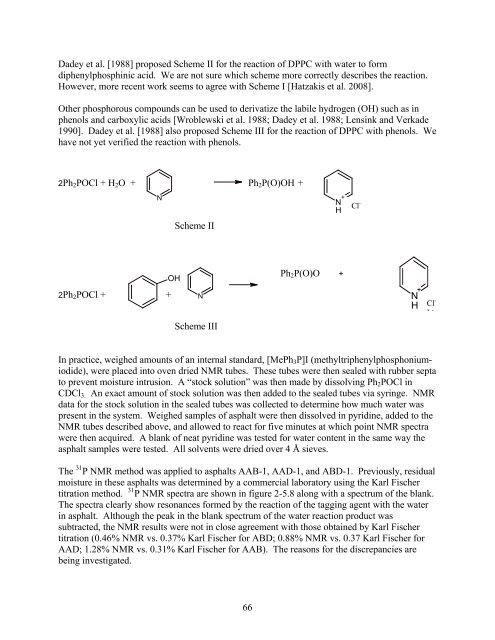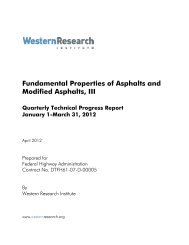Fundamental Properties of Asphalts and Modified Asphalts, III
Fundamental Properties of Asphalts and Modified Asphalts, III
Fundamental Properties of Asphalts and Modified Asphalts, III
You also want an ePaper? Increase the reach of your titles
YUMPU automatically turns print PDFs into web optimized ePapers that Google loves.
Dadey et al. [1988] proposed Scheme II for the reaction <strong>of</strong> DPPC with water to form<br />
diphenylphosphinic acid. We are not sure which scheme more correctly describes the reaction.<br />
However, more recent work seems to agree with Scheme I [Hatzakis et al. 2008].<br />
Other phosphorous compounds can be used to derivatize the labile hydrogen (OH) such as in<br />
phenols <strong>and</strong> carboxylic acids [Wroblewski et al. 1988; Dadey et al. 1988; Lensink <strong>and</strong> Verkade<br />
1990]. Dadey et al. [1988] also proposed Scheme <strong>III</strong> for the reaction <strong>of</strong> DPPC with phenols. We<br />
have not yet verified the reaction with phenols.<br />
2Ph2POCl + H2O + Ph2P(O)OH +<br />
OH<br />
2Ph2POCl + +<br />
N<br />
Scheme II<br />
N<br />
Scheme <strong>III</strong><br />
66<br />
Ph2P(O)O +<br />
In practice, weighed amounts <strong>of</strong> an internal st<strong>and</strong>ard, [MePh3P]I (methyltriphenylphosphoniumiodide),<br />
were placed into oven dried NMR tubes. These tubes were then sealed with rubber septa<br />
to prevent moisture intrusion. A “stock solution” was then made by dissolving Ph2POCl in<br />
CDCl3. An exact amount <strong>of</strong> stock solution was then added to the sealed tubes via syringe. NMR<br />
data for the stock solution in the sealed tubes was collected to determine how much water was<br />
present in the system. Weighed samples <strong>of</strong> asphalt were then dissolved in pyridine, added to the<br />
NMR tubes described above, <strong>and</strong> allowed to react for five minutes at which point NMR spectra<br />
were then acquired. A blank <strong>of</strong> neat pyridine was tested for water content in the same way the<br />
asphalt samples were tested. All solvents were dried over 4 Å sieves.<br />
The 31 P NMR method was applied to asphalts AAB-1, AAD-1, <strong>and</strong> ABD-1. Previously, residual<br />
moisture in these asphalts was determined by a commercial laboratory using the Karl Fischer<br />
titration method. 31 P NMR spectra are shown in figure 2-5.8 along with a spectrum <strong>of</strong> the blank.<br />
The spectra clearly show resonances formed by the reaction <strong>of</strong> the tagging agent with the water<br />
in asphalt. Although the peak in the blank spectrum <strong>of</strong> the water reaction product was<br />
subtracted, the NMR results were not in close agreement with those obtained by Karl Fischer<br />
titration (0.46% NMR vs. 0.37% Karl Fischer for ABD; 0.88% NMR vs. 0.37 Karl Fischer for<br />
AAD; 1.28% NMR vs. 0.31% Karl Fischer for AAB). The reasons for the discrepancies are<br />
being investigated.<br />
N +<br />
H<br />
Cl -<br />
N +<br />
H Cl-<br />
L -





